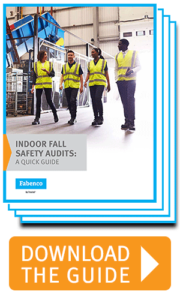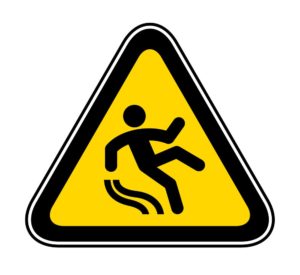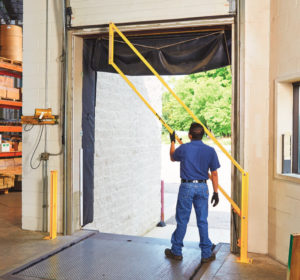
As the owner or safety manager of a business, it’s your responsibility to protect the rights of your employees. At the top of this list of rights is the right to work in an environment that is “free of known health and safety hazards.” With slips and falls being some of the most common workplace injuries, this isn’t something to shirk off. It’s up to you to establish a fall protection strategy. Fortunately, The National Safety Council notes that falls are 100% preventable — so long as you set your excuses aside and make safety your number one priority. If any of the below sound familiar, you’re in need of a safety audit.
Excuse #1: “We don’t have enough falls to warrant regular reviews.”
Reality: Just one fall puts your employees and your business at risk.
While OSHA penalties are definitely more severe and costly for businesses that are repeat fall protection violation offenders, it’s still important to be aware of the consequences and penalties associated with this safety risk for businesses that have never had a fall incident. Just one fall or one violation is enough to warrant harsh financial penalties and perhaps even prison time for business owners who fail in this regard.
Regular reviews are one of the best ways to ensure that your business is on the right path to preventing falls. You can work with your safety and compliance team to create a review schedule that involves periodic spot checks of the proper use of safety equipment.
Excuse #2: “We have never been cited before, so we do not need a review.”
Reality: It only takes one oversight or mistake for OSHA to issue a penalty.
Maximum OSHA penalties can range from $13,260 per violation to $132,598 per repeated violations. In addition to potentially costing your business hundreds of thousands of dollars in penalties, a fall-related injury could have a devastating impact on your company’s reputation. By scheduling regular reviews, you can help prevent one oversight from causing injury and casting a dark shadow on your business.
Excuse #3: “Our facility has plenty of safety signage posted.”
Reality: Safety signage is great but it’s only one component of an effective fall protection platform.
An effective fall safety program is comprehensive and multifaceted. In addition to safety signage, a sound program might feature self retracting lifelines, fall protection equipment, and a safety gate in areas where the risk of falls is high, depending on the situation. High-risk areas include loading docks, mezzanines, rooftop edges, and floor holes.
Excuse #4: “We do not have a multi-level facility so falls are not a concern.”
Reality: Single floor facilities are often full of fall risks.
When many people think of workplace fall hazards, they envision unsecured balconies, stairwells, and mezzanines that are found in multi-story facilities. However, single-story workplaces are full of fall risks. Here are just a few areas that pose an increased fall risk to employees working in single-story buildings:
- Loading docks
- Floor holes
- Wet or slippery floors
- Rooftop access ladders
These areas deserve special attention during the review process. A safety gate, railings, and signage are all useful means of minimizing the risk of falls in or around these hot spots.
Excuse #5: “All of our employees have been trained to be careful.”
Reality: Training does not occur in a vacuum and regular reviews are necessary.
A sound fall prevention training program is the cornerstone of a safe work environment. Fall prevention training should be provided in detail before employees officially assume their job responsibilities, as well as on a periodic basis moving forward. Through continuous training, safety best practices not only stay sharp but top of mind. Training also needs to focus on how to use protective equipment like self retracting lifelines and harnesses just as much as fall awareness. As outlined below, training to prevent falls should always be provided in a language that employees can understand:
“…An employer must instruct its employees using both a language and vocabulary that the employees can understand. For example, if an employee does not speak or comprehend English, instruction must be provided in a language the employee can understand. Similarly, if the employee’s vocabulary is limited, the training must account for that limitation.”
– David Michaels, Ph.D., MPH, Assistant Secretary for Occupational Safety and Health (OSHA)
Excuse #6: “We have other more pressing priorities to focus on.”
Reality: Protecting your employees and visitors from injury should be your top priority.
Your employees have rights, and OSHA states that providing a “workplace free of known health and safety hazards” is your responsibility as a business owner. At any point in time, your employees have the right to contact OSHA or file a complaint about the working conditions at your facility.
OSHA clearly states that employees also have the right to be “provided required safety gear, such as gloves or a harness and lifeline for falls,” and to “review records of work-related injuries and illnesses.” These specific rights outline how critical it is for your facility to regularly review the measures you take to prevent falls.
Excuse #7: “We need to focus our energies on things that make us money.”
Reality: Given the high cost of injuries and OSHA penalties, you can hardly afford NOT to have a review.

Whether you opt for a cost-effective safety gate, self retracting lifelines with a harness, or a combination of a variety of fall protection equipment, there are many affordable measures you can take to build a foundation for a fruitful review.
The Bottom Line
Reviewing your fall protection strategy is vital to creating a safe, secure work environment that is compliant with the latest OSHA regulations. Simple measures such as installing a safety gate or investing in fall protection equipment can put your facility on the fast track to fall prevention. To succeed in your efforts to protect your employees from dangerous falls, be sure to remain abreast of OSHA’s latest guidelines and recommendations. And most importantly, avoid making excuses for critical reviews.















